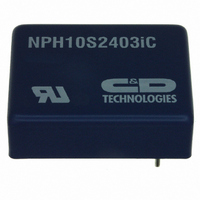NPH10S2403IC Murata Power Solutions Inc, NPH10S2403IC Datasheet - Page 4

NPH10S2403IC
Manufacturer Part Number
NPH10S2403IC
Description
CONV DC/DC 10W 24VIN 3.4VOUT DIP
Manufacturer
Murata Power Solutions Inc
Series
NPH10Sr
Type
Isolatedr
Datasheet
1.NPH10S2412IC.pdf
(8 pages)
Specifications of NPH10S2403IC
Number Of Outputs
1
Output
3.4V
Power (watts)
10W
Mounting Type
Through Hole
Voltage - Input
18 ~ 36V
Package / Case
6-DIP Module
1st Output
3.4 VDC @ 2.94A
Size / Dimension
1.26" L x 0.98" W x 0.39" H (32mm x 24.9mm x 9.9mm)
Power (watts) - Rated
10W
Operating Temperature
-40°C ~ 110°C
Efficiency
79%
Approvals
UL
Output Power
10 W
Input Voltage Range
18 V to 36 V
Input Voltage (nominal)
24 V
Output Voltage (channel 1)
3.4 V
Output Current (channel 1)
2.94 A
Isolation Voltage
1.5 KV
Package / Case Size
DIP
Product
Isolated
Lead Free Status / RoHS Status
Lead free / RoHS Compliant
3rd Output
-
2nd Output
-
4th Output
-
Lead Free Status / Rohs Status
Lead free / RoHS Compliant
Other names
811-1624-5
Available stocks
Company
Part Number
Manufacturer
Quantity
Price
Company:
Part Number:
NPH10S2403IC
Manufacturer:
C&DTech
Quantity:
492
APPLICATION NOTES (continued)
TECHNICAL NOTES
ISOLATION VOLTAGE
‘Hi Pot Test’, ‘Flash Tested’, ‘Withstand Voltage’, ‘Proof Voltage’, ‘Dielectric Withstand Voltage’ & ‘Isolation Test Voltage’ are all terms that relate to the same thing, a test voltage,
applied for a specifi ed time, across a component designed to provide electrical isolation, to verify the integrity of that isolation.
Murata Power Solutions NPH10S series of dc/dc converters are all 100% production tested at their stated isolation voltage. This is 1500V DC for 1 second.
A question commonly asked is, “What is the continuous voltage that can be applied across the part in normal operation?”
The NPH10S series has been recognized by Underwriters Laboratory, both input and output should normally be maintained within SELV limits i.e. less than 42.4V peak, or 60VDC.
The isolation test voltage represents a measure of immunity to transient voltages and the part should never be used as an element of a safety isolation system. The part could be
expected to function correctly with several hundred volts offset applied continuously across the isolation barrier; but then the circuitry on both sides of the barrier must be regarded
as operating at an unsafe voltage and further isolation/insulation systems must form a barrier between these circuits and any user-accessible circuitry according to safety standard
requirements.
REPEATED HIGH-VOLTAGE ISOLATION TESTING
It is well known that repeated high-voltage isolation testing of a barrier component can actually degrade isolation capability, to a lesser or greater degree depending on materi-
als, construction and environment. While manufactured parts can withstand several times the stated test voltage, the isolation capability does depend on the wire insulation. Any
material, including this enamel (typically polyurethane) is susceptible to eventual chemical degradation when subject to very high applied voltages thus implying that the number of
tests should be strictly limited. We therefore strongly advise against repeated high voltage isolation testing, but if it is absolutely required, that the voltage be reduced by 20% from
specifi ed test voltage.
www.murata-ps.com
SYNCHRONISATION
The converter frequency may be synchronised to an external frequency by connecting a negative going pulse to the SS pin. The drive signal is typically
8V to 12V amplitude and 100ns to 200ns duration. A suitable circuit consists of a CMOS timer (TLC555) connected as an oscillator or as a pulse shaper.
Its logic output (not the discharge output) should be connected via a 4.7nF capacitor to the converter pin. The synchronised frequency is above the free
running value. However, the free running frequency can be lowered, so that sychronisation may include frequencies near or below the natural value.
An example of a practical circuit is shown below, which uses a zener diode to lower the natural frequency. Several converters of this family may be
synchronised from the same reference provided the waveform can be maintained by the use of an adequate driver circuit. If the rise time is more than
20ns, for example, synchronisation may not be achieved over the specifi ed frequency range.
For best effi ciency, set the frequency within the specifi ed range of its natural state.
Technical enquiries email: mk@murata-ps.com, tel: +44 (0)1908 615232
Isolated 10W Single Output DC/DC Converters
2010-03-01 KDC_NPH10SC.I03 Page 4 of 8
NPH10S Series




















